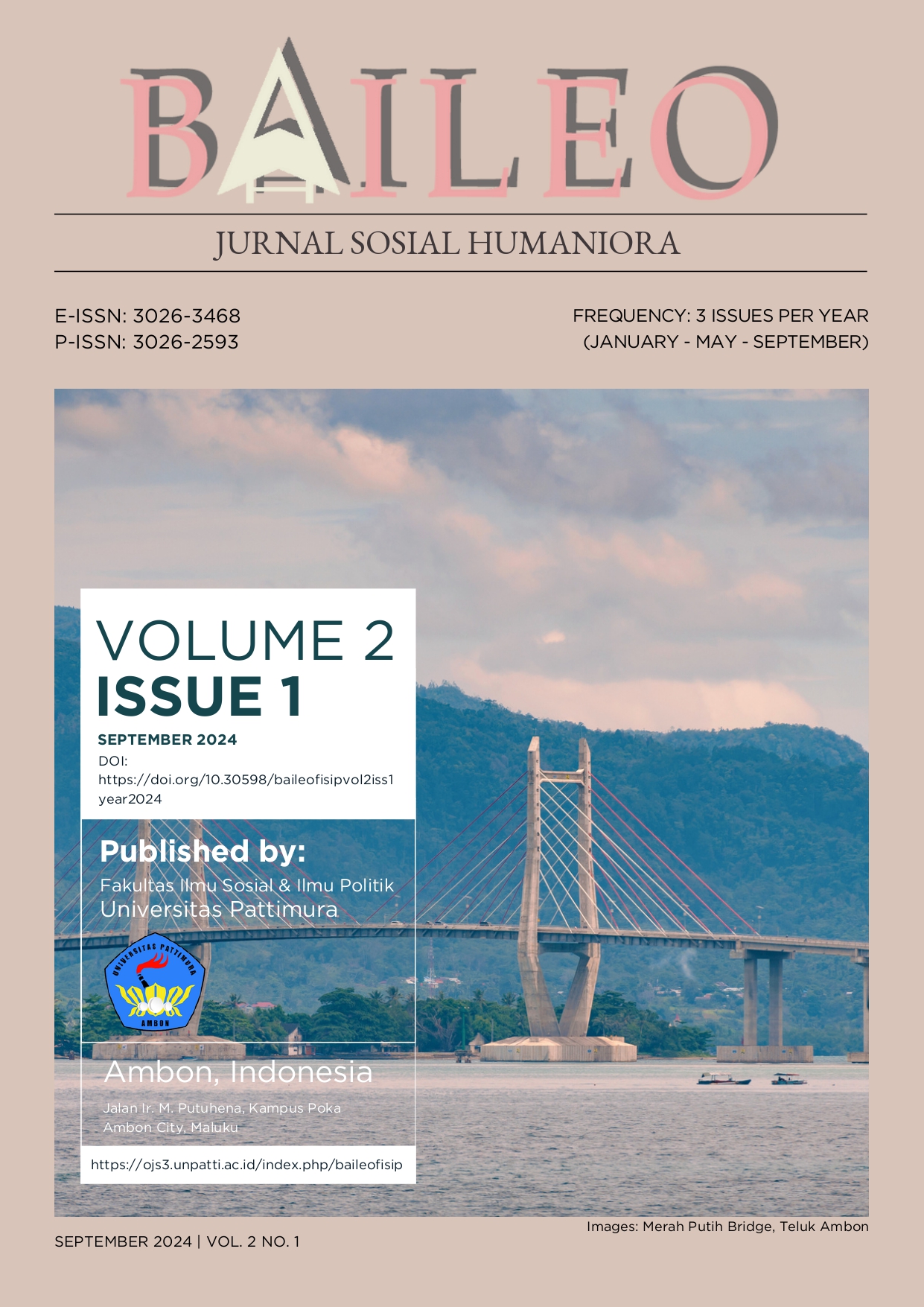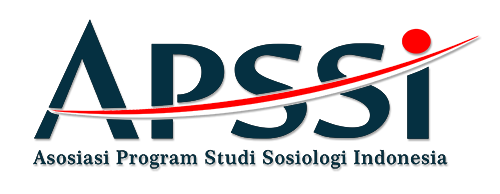Synergy Between Bank Indonesia and the Maluku Government: Implementation of Philip Lesly’s Communication Model in Inflation Control
Abstract
This study aims to describe the communication synergy between Bank Indonesia and the Maluku Provincial Government in controlling inflation through the implementation of Philip Lesley’s communication planning model. This synergy is manifested in the Regional Inflation Control Team (TPID) of Maluku, where Bank Indonesia acts as the Organizing Entity and the Maluku Provincial Government as the target public. This research uses a qualitative descriptive method, with data collected through observation, interviews, and documentation. The findings show that the communication synergy between the two institutions operates effectively through four planning stages: analysis and research, policy formulation, program planning, and communication activities. Additionally, the Maluku Provincial Government plays a role in providing feedback and evaluation through its involved Regional Government Organizations (OPD). The novelty of this research lies in the structured application of Philip Lesley’s communication model in the context of inflation control in Maluku, illustrating how strategic communication can strengthen inter-agency cooperation to achieve economic goals. The study concludes that successful inflation control in Maluku is highly dependent on targeted communication planning and clear role distribution between Bank Indonesia and the Maluku Provincial Government.
Downloads
References
Abaidoo, R., & Agyapong, E. K. (2024). Commodity prices, inflation and inflation uncertainty among emerging economies. Journal of Economic and Administrative Sciences, 40(3), 622–640. https://doi.org/10.1108/JEAS-10-2021-0203
Afdhal. (2023). Konsep Komunikasi dalam Bisnis. In Komunikasi Bisnis (Vol. 1, pp. 1–14). PT. Global Eksekutif Teknologi.
Anwar, G., & Abdullah, N. N. (2021). The impact of Human resource management practice on Organizational performance. International Journal of Engineering, Business and Management, 5(1), 35–47. https://doi.org/10.22161/ijebm.5.1.4
Bakhtiar, B. (2023). Challenges and Problems in Implementing the People’s Business Credit Program in Makassar City, South Sulawesi Province. International Journal of Social Science Research and Review, 6(3), 512–528.
Bardhan, N., & Gower, K. (2020). Student and faculty/educator views on diversity and inclusion in public relations: The role of leaders in bringing about change. Journal of Public Relations Education, 6(2), 102–141.
Bergstrom, T., Rieger, O. Y., & Schonfeld, R. C. (2024). Governance and Business Models for Collaborative Collection Development.
Bowen, G. A. (2019). Document Analysis as a Qualitative Research Method. Qualitative Research Journal, 9(2), 27–40. https://doi.org/10.3316/QRJ0902027
Bryson, J. M., Quick, K. S., Slotterback, C. S., & Crosby, B. C. (2013). Designing Public Participation Processes. Public Administration Review, 73(1), 23–34. https://doi.org/10.1111/j.1540-6210.2012.02678.x
Charaia, V., & Papava, V. (2022). On the Inflation and its Modifications in the Era of Global Pandemic: The Case of Some ADB Countries. Journal of Asian Finance, Economics and Business, 9(8), 7–17.
Chen, J., Yin, S., & Yang, X. (2023). The impact of adaptive management on community resilience in arid rural areas facing environmental change: An integrated analytical framework. Environmental Science & Policy, 150(12), 103589. https://doi.org/10.1016/j.envsci.2023.103589
Creswell, J. W. (2017). Research Design: Qualitative, Quantitative, and Mixed Methods Approaches. Sage publications.
Dupont, C., & Skjold, A. (2022). Coordination Conundrum in the United Nations Development System: Solutions from Self-Managed Organizations. Global Perspectives, 3(1), 57083. https://doi.org/10.1525/gp.2022.57083
Gómez-Galán, J. (2020). Media Education in the ICT Era: Theoretical Structure for Innovative Teaching Styles. Information, 11(5), 276–286. https://doi.org/10.3390/info11050276
Hanson, R. B., Vano, J., Grant, G., Pandya, R., Shimamoto, M., & Lyon, L. (2021). Report to NSF on AGU community recommendations and ideas regarding implementing Climate Change Solutions. In Authorea Preprints. Authorea. https://doi.org/10.1002/essoar.10507256.2
Hart, S. U. (2024). From promise to practice: A cross-institutional analysis of design trends, enablers and challenges in blockchain-enabled cash and voucher delivery. International Journal of Disaster Risk Reduction, 100(12), 104129. https://doi.org/10.1016/j.ijdrr.2023.104129
Huawei, T. (2022). Does gross domestic product, inflation, total investment, and exchanges rate matter in natural resources commodity prices volatility. Resources Policy, 79, 103013. https://doi.org/10.1016/j.resourpol.2022.103013
Hyland-Wood, B., Gardner, J., Leask, J., & Ecker, U. K. H. (2021). Toward effective government communication strategies in the era of COVID-19. Humanities and Social Sciences Communications, 8(1), 1–11. https://doi.org/10.1057/s41599-020-00701-w
Iqbal, M. H., Siddiqie, S. A., & Mazid, M. A. (2021). Rethinking theories of lesson plan for effective teaching and learning. Social Sciences & Humanities Open, 4(1), 100172. https://doi.org/https://doi.org/10.1016/j.ssaho.2021.100172
Lambert, V. A., & Lambert, C. E. (2021). Qualitative descriptive research: An acceptable design. Pacific Rim International Journal of Nursing Research, 16(4), 255–256.
Larter, L. C. (2022). Communication Networks, Eavesdropping, and Audience Effects. In Encyclopedia of Animal Cognition and Behavior (pp. 1548–1557). Springer International Publishing. https://doi.org/10.1007/978-3-319-55065-7_1661
Lesley, P. (1979). Psychology and public relations counseling. Public Relations Review, 5(3), 3–9. https://doi.org/10.1016/S0363-8111(79)80023-5
Miles, M. B., & Huberman, A. M. (2020). Qualitative Data Analysis: An Expanded Sourcebook (9th ed.). sage.
Moktadir, M. A., Kumar, A., Ali, S. M., Paul, S. K., Sultana, R., & Rezaei, J. (2020). Critical success factors for a circular economy: Implications for business strategy and the environment. Business Strategy and the Environment, 29(8), 3611–3635. https://doi.org/10.1002/bse.2600
Octaviani, F., Raharjo, S. T., & Resnawaty, R. (2022). Strategi Komunikasi dalam Corporate Social Responsibility Perusahaan sebagai upaya Pemberdayaan Masyarakat. Jurnal Ilmu Kesejahteraan Sosial HUMANITAS, 4(I), 21–33. https://doi.org/10.23969/humanitas.v4iI.4882
Owen, G. (2020). What makes climate change adaptation effective? A systematic review of the literature. Global Environmental Change, 62(1), 102071. https://doi.org/10.1016/j.gloenvcha.2020.102071
Rogers, M. L., & Turner, J. (2021). African American Political Thought. University of Chicago Press. https://doi.org/10.7208/chicago/9780226726076.001.0001
Safarudin, R., Zulfamanna, Z., Kustati, M., & Sepriyanti, N. (2023). Penelitian kualitatif. Innovative: Journal Of Social Science Research, 3(2), 9680–9694.
Sembiring, R. S. R., Zulkarnain, I., Dapi, M. D., & Sukmana, E. T. (2022). Performance Management of The Regional Inflation Control Team Central Kalimantan Province In Inflation Control. Jurnal Al-Qardh, 7(1), 30–43. https://doi.org/10.23971/jaq.v7i1.4116
Thursky, K. A., Hardefeldt, L. Y., Rajkhowa, A., Ierano, C., Bishop, J., Hawes, L., Biezen, R., Saha, S. K., Dowson, L., Bailey, K. E., Scarborough, R., Little, S. B., Gotterson, F., Hur, B., Khanina, A., Urbancic, K., Crabb, H. K., Richards, S., Sri, A., … Koning, S. (2021). Antimicrobial stewardship in Australia: the role of qualitative research in programme development. JAC-Antimicrobial Resistance, 3(4), dlab166. https://doi.org/10.1093/jacamr/dlab166
Van Ruler, B. (2020). Communication theory: An underrated pillar on which strategic communication rests. In Future directions of strategic communication (pp. 39–53). Routledge.
Vera Figueroa, M. E., & Vera Maldonado, A. P. (2024). Advantages and disadvantages of the thinkpair-share technique to enhance speaking skill. La Libertad, Universidad Estatal Península de Santa Elena, 2024.
Wartoyo, W., Lutfiyanti, L., & Ainun, A. S. (2024). Analysis of Monetary Strategies and Policies to Manage the Inflation and Public Purchasing Power in Indonesia. Jurnal Ekonomi Syariah, Akuntansi Dan Perbankan (JESKaPe), 8(1), 1–23.
Yar, F. G. M., & Yasouri, M. (2024). Rural Development Challenges in Addition to Effective Solutions to Overcome Obstacles. Zhongguo Kuangye Daxue Xuebao, 29(3), 79–90.
Yin, R. K. (2014). Case Study Research: Design and Methods (5th (ed.)). SAGE Publications.
Zhang, Y., Sun, J., Yang, Z., & Wang, Y. (2020). Critical success factors of green innovation: Technology, organization and environment readiness. Journal of Cleaner Production, 264(12), 121701. https://doi.org/10.1016/j.jclepro.2020.121701
Copyright (c) 2024 Yohanes Brilian F. Kulwembun, Ronald Alfredo, Yuniar Sakinah Waliulu

This work is licensed under a Creative Commons Attribution 4.0 International License.




